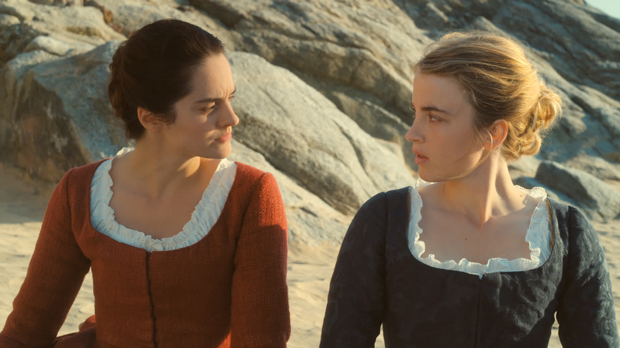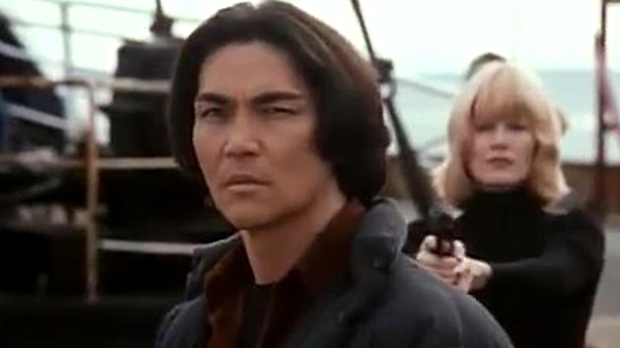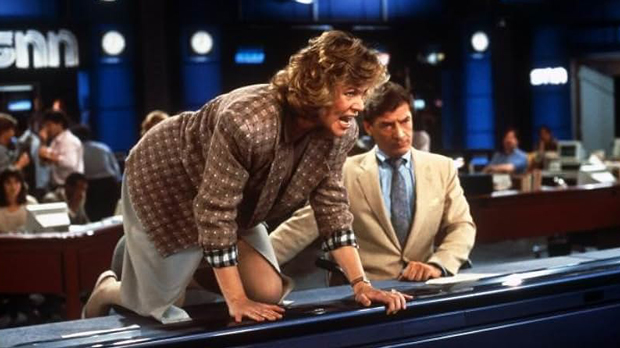 Portrait of a Lady on Fire (2019) Neon/Drama RT: 121 minutes Rated R (some nudity and sexuality) Director: Celine Sciamma Screenplay: Celine Sciamma Music: Jean-Baptiste de Laubier and Arthur Simonini Cinematography: Claire Mathon Release date: February 21, 2020 (Philadelphia, PA) Cast: Noemie Merlant, Adele Haenel, Luana Bajrami, Valeria Golino. Spoken in French w/English subtitles
Portrait of a Lady on Fire (2019) Neon/Drama RT: 121 minutes Rated R (some nudity and sexuality) Director: Celine Sciamma Screenplay: Celine Sciamma Music: Jean-Baptiste de Laubier and Arthur Simonini Cinematography: Claire Mathon Release date: February 21, 2020 (Philadelphia, PA) Cast: Noemie Merlant, Adele Haenel, Luana Bajrami, Valeria Golino. Spoken in French w/English subtitles
Rating: ***
I was going through some old newspaper clippings that I saved from childhood when I came across an ad for the 1982 movie Personal Best starring Mariel Hemingway and Patrice Donnelly as a pair of Olympic track stars who become romantically involved. It was quite controversial at the time as I recall. It openly and explicitly dealt with the type of relationship that, in real life, only existed in secret. It’s not one of my favorite films, but I give the makers props for tackling a subject that rarely (if ever) came up in polite company.
We’ve come a long way since 1982, cinematically speaking. I doubt a film like Celine Sciamma’s period drama Portrait of a Lady on Fire would get made. Set in the late 18th century, it too deals with a passionate love affair between two women. In this case, it’s an artist and her subject. Painter Marianne (Merlant) has been commissioned to paint the likeness of Heloise (Haenel), a young woman about to be married off to a Milanese nobleman. As per custom, he wants a portrait of his bride-to-be before the wedding takes place. Heloise, not exactly enthused about the prospect of marriage, stubbornly refuses to sit for one. Her mother, a countess (Golino, Rain Man), decides to keep her daughter in the dark about Marianne’s true purpose for being there instead telling Heloise that she’s been brought here as a companion for her. While accompanying Heloise on her daily walks, Marianne is to secretly observe her, taking in every contour and detail so she can paint the portrait later from memory.
Marianne finishes the portrait, but neither she nor Heloise is satisfied with it. Much to her mother’s surprise, Heloise agrees to pose for Marianne for a redo. The artist promises to have it done by the time the Countess returns from her trip to Italy. It’s during this time they act on their unspoken attraction in defiance of patriarchal customs. It’s a consuming affair that must stay concealed because society forbids it. But in the privacy of a cliffside manor on the coast of Brittany, they can explore their love and each other. Of course, a love like theirs can’t last.
Sciamma widens the feminist scope of Portrait of a Lady on Fire by including the story of housemaid Sophie (Bajrami) who wants to get an abortion. Marianne and Heloise help her obtain one surreptitiously. The three ladies now share the common bond of defying 18th century gender and societal conventions.
Although Sciamma doesn’t hold back in depicting sexuality, this is NOT where Portrait of a Lady on Fire reaches its erotic apex. This is found in the sensual longing evident in the exchanged stares between Marianne and Heloise. Look at the way the camera caresses their skin also. It’s far more erotic than any given scene in any movie with Fifty Shades in the title. It helps that Sciamma directs with artful skill, using contrasts of light and shadow to maximum effect. And check out the smooth textures and layered compositions. Sciamma paints a gorgeous picture of forbidden love in the 18th century.
Portrait of a Lady on Fire also examines the liberating power of art. The portrait of Heloise is ultimately how Marianne sees her. Not satisfied with her first effort, she destroys it so she can do right by Heloise, a woman who creates stirrings she never knew existed. Through her work, she can express feelings that would normally be frowned upon by society.
The acting in Portrait of a Lady on Fire is very good. The cast is primarily female; men are rarely even seen. The attraction between Marianne and Heloise is palpable thanks to Merlant and Haenel and their perfectly calibrated performances. They’re so natural and believable. Haenel imbues her character with sadness consistent with being forced to conform to a role in which she clearly doesn’t belong. The scene where she runs towards the edge of a bluff is representative of the freedom she desires. Bajrami is also good as the maid whose story unifies rather than divides the narrative and its themes. In other words, her story never feels extraneous. Golino is terrific as the mother who wants her daughter to marry for financial reasons. He’s rich so it must be a good match.
As gorgeous as Portrait of a Lady on Fire is, it’s also slow-moving. Well, I expected that. However, I didn’t really mind too much. It gave me time to take in the sets, costumes and scenery. The production design by Thomas Grezaud is beautiful as is the score by Jean-Baptiste de Laubier and Arthur Simonini. There’s this one great nighttime scene where all the women on the island come together in song by a bonfire. Sciamma also makes great use of “Summer” from Vivaldi’s The Four Seasons. As you can see, there’s plenty to admire about this film. I don’t know how well it would have played to 1982 audiences, but any way you look at it, it’s a beautifully sad love story.




